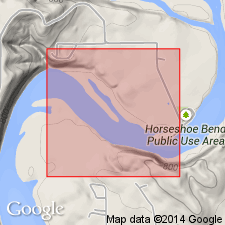
- Usage in publication:
-
- Welling Formation
- Modifications:
-
- Named
- Reference
- Dominant lithology:
-
- Limestone
- AAPG geologic province:
-
- Chautauqua platform
- Arkoma basin
- South Oklahoma folded belt
Summary:
Name applied to some rocks formerly referred to as Fernvale Limestone, a name from central TN. Named for the town of Welling near the type locality at Horseshoe Bend of the Illinois River, Cherokee Co, OK on the Chautauqua platform where it is about 20 ft thick, overlies Fite Limestone, and underlies Sylvan Shale. Reference section designated in OGS 3 core in SE1/4 SE1/4 NE1/4 sec 20, T13N, R21E, Sequoyah Co in the Arkoma basin. Consists of obscurely bedded, low-magnesium, organo-detrital limestone with minor detrital quartz grains especially in the lower part. The dominant cement is spar with some minor micrite. Pelmatozoan plates dominate the clasts in most beds. Brachiopods, trilobites, bryozoans, and other shelly debris abundant. Maintains its lithologic identity over a large area from Coal Co in the Arkoma basin to the Arbuckle Mountains in Murray Co in the S. Oklahoma folded belt province. Is widely distributed in the subsurface. Assigned to Richmondian, or Late Ordovician. Correlation chart. Columnar section.
Source: GNU records (USGS DDS-6; Denver GNULEX).
For more information, please contact Nancy Stamm, Geologic Names Committee Secretary.
Asterisk (*) indicates published by U.S. Geological Survey authors.
"No current usage" (†) implies that a name has been abandoned or has fallen into disuse. Former usage and, if known, replacement name given in parentheses ( ).
Slash (/) indicates name conflicts with nomenclatural guidelines (CSN, 1933; ACSN, 1961, 1970; NACSN, 1983, 2005, 2021). May be explained within brackets ([ ]).

